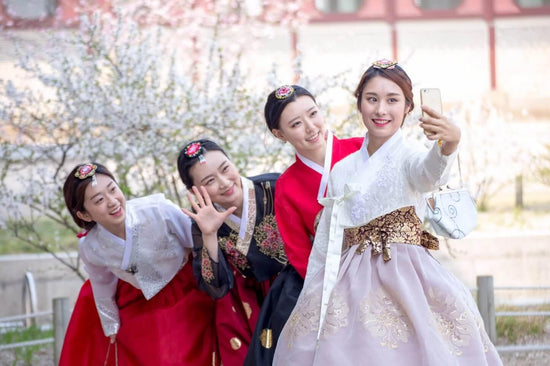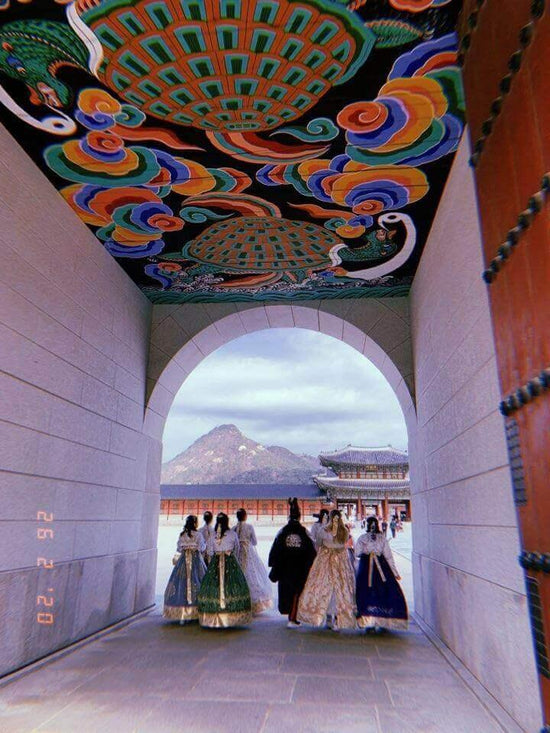Modern Hanbok: Reinventing Korean Tradition for the Contemporary Wardrobe

When people think about South Korea, the traditional Hanbok is one of the first images to appear - proof of its cultural significance. These days, the Modern Hanbok allows people to express their love and pride for Korean culture. It represents a deep-rooted connection to the country's rich history and traditions.
Why don’t we get into the article and familiarize ourselves with its historical background and its rise in the present times?
What is Hanbok?
Hanbok, which literally translates to "Korean clothing," is the traditional outfit worn by men, women, and children in Korea. In its simplest form, it comprises a waistcoat (jeogori), a skirt or trousers (chima or baji), and an overcoat (durumagi).
While it's frequently worn by Koreans for significant festivities, birthdays (such as 'dol'), and wedding ceremonies, the profound historical context and importance attached to traditional Hanbok remains unknown to a considerable number of Koreans.

Photo from Creatrip
Women's Hanbok
The women's Hanbok is a beautiful blend of vibrant colors, elegant lines, and intricate details. The jeogori is a short jacket with long sleeves tied at the front with a ribbon or string. The chima is a high-waisted, full-length skirt with a graceful flow to the overall look.
Men's Hanbok
While maintaining the fundamental components of the jeogori and durumagi, the men's Hanbok swaps the skirt for baji - loose, comfortable trousers. The men's jeogori is typically longer than the women's, extending down to the waist.
A Journey Through History: The Evolution of Hanbok
The evolution of Hanbok is a fascinating journey through Korea's rich history. It serves as a lens into the cultural and historical shifts in the country over centuries. To truly understand why modern Hanbok is a hit among idols and to share helpful tips on how to wear it, why don't we journey back in time?
Let's hop onto our time machine and zoom back 2000 years. We're off to explore the fascinating story of this traditional Korean garment, rich in cultural heritage and steeped in historical significance.
Traced back to the Three Kingdoms period (37 BCE-676 CE), Korea was divided into the Goguryeo, Baekje, and Silla Kingdoms. Each kingdom contributed to the development of Hanbok in unique ways, reflecting their distinct cultures and traditions.
Then, during the late 19th and early 20th centuries, Western clothing influenced Korean fashion. This period marked a decline in the popularity of Hanbok as people adopted Western-style clothing.
Referring to the Modern Era, in the 20th century, Hanbok underwent a revival as Koreans sought to preserve their cultural heritage. In the past, the white Hanbok, especially, symbolized important things for Koreans throughout history, like purity, unity, and resistance. Now, modern interpretations of the Hanbok have begun to emerge, combining traditional elements with contemporary design.

Mural painting from Susan-ri
Today, however, Hanbok continues to evolve. Traditional Hanbok is still worn for special occasions like weddings and holidays; modern interpretations and adaptations, known as Modern Hanbok, have gained popularity for everyday wear. These contemporary versions maintain the essence of traditional Hanbok while offering greater comfort and versatility.

Photo found in flicker
Throughout its history, Hanbok has served as clothing and a reflection of Korean culture and societal values. It continues to be an essential symbol of Korean identity and heritage.
The Rise of Modern Hanbok
All that said, and after understanding a little about the story of the Hanbok and why people used it in the past, it's time to proceed in the present. Modern Hanbok offers a unique and visually appealing aesthetic that stands out from other fashion trends.
Like other music styles such as Jazz, blues, or what we know as pop, modern Hanbok has evolved in time. Its blend of traditional and contemporary elements creates a striking and distinctive style.

Photo taken from Leesle’s Instagram
Designers and fashion enthusiasts have helped revive Hanbok's interest, creating modern and stylish versions that blend traditional elements with contemporary aesthetics. They often combine conventional Korean elements, such as silhouette, fabric, and motifs, with modern fashion sensibilities. This fusion results in clothing rooted in tradition and suitable for today's lifestyle.
One difference between the traditional Hanbok and the Modern one is that the first has a distinct silhouette characterized by its broad, flowing skirts and fitted jeogori (jacket). Modern Hanbok may feature simplified silhouettes with slimmer, more streamlined shapes. This makes them more practical for everyday wear.
Colors are fundamental to this traditional (now modernized) clothing. Designers try experimenting with various colors and fabrics -including silk, satin, and linen.
They often incorporate bold and vibrant colors alongside traditional colors like white, blue, and black. This adds a contemporary twist to the traditional aesthetic.

Photo taken from Leesle’s Instagram
In the introduction, we mentioned Modern Hanbok is a gender-neutral daily option. That's because, even though Traditional Hanbok designs are often gender-specific, with distinct styles for men and women, modern ones have been introduced to options that anyone can wear regardless of gender.
Last but not least, Modern Hanbok designers often create more affordable options, making it easier for people to incorporate Hanbok-inspired pieces into their wardrobes. Knowing that Traditional Hanbok is expensive, this accessibility is crucial.
All of this said, if you're considering having your Modern Hanbok, you must know you can customize it! Designers offer customization options, allowing customers to choose their preferred colors, fabrics, and details. Let's have a unique and personalized piece!
Idols Using Modern Hanbok
Several Korean idols and celebrities have been known to incorporate Modern Hanbok into their fashion choices. Modern Hanbok offers a unique and stylish twist on traditional Korean clothing, making it a popular choice for public appearances, performances, and photoshoots.
Keep in mind that the popularity of specific idols and their fashion choices can change over time, so it's a good idea to check the latest updates to see which idols are currently wearing Modern Hanbok.
Here are a few K-pop idols who have been associated with Modern Hanbok:
BTS (Bangtan Sonyeondan): BTS members are known for their diverse fashion choices. They have been seen wearing Modern Hanbok-inspired outfits at various events, such as in their IDOL MV.

Photo from Amino Apps
BLACKPINK: Members of BLACKPINK (Rosé, Jisoo Lisa and Jennie) have worn Modern Hanbok-inspired outfits in their How You Like That MV.

Photo from Ornatun.com
ATEEZ: ATEEZ is a boy group known for their unique fashion sense. They have incorporated Modern Hanbok elements into their stage outfits, such as when they performed on National Liberation Day in 2020.

Photo from Pinterest
KARD: In 2020, the 4-member group KARD partnered with Leesle, a company that specializes in designing and crafting modern Hanboks, in their endeavor to promote hanbok outside Korea.

Photo from Kpopmap
SUPERM: SuperM uniquely blended tradition with modernity by incorporating contemporary adaptations of the Hanbok for their song Tiger Inside. Their attire was a fascinating fusion of the conventional Korean garb and a more current fashion aesthetic.
ITZY: ITZY, a girl group under JYP Entertainment, has embraced Modern Hanbok for its music video outfits and dance practices, blending traditional and contemporary aesthetics.

Photo form X
Stray Kids: SKZ also showcased their remarkable fashion sense during their Back Door promotion. Their modern Hanbok outfits added more angst to their looks and overall presence.

Photo from Koreaboo
These are just a few examples, and many more K-pop idols and celebrities have explored the world of Modern Hanbok to create visually stunning and culturally significant fashion statements. Remember that K-pop and celebrity fashion trends can evolve rapidly, so new developments and idols may embrace Modern Hanbok in the following years. Don't worry; the Daebak Company is here to help you stay tuned!
What is the male version of Hanbok?
For men, Hanbok consists of jeogori and loose-fitting baji (trousers), known as Chima Jeogori. However, Modern Hanbok is a gender-neutral clothing.
Where can I buy a Modern Hanbok in Seoul?
In case you are in Seoul, some of the best or most popular are at the entrance to Ssamziegil in Insadong, Suseolhwa at Hapjeong station exit 8, and Teterot Salon in Ikseondong. But don't worry, you can buy some of this incredible clothing in many places and shops.
When do people use traditional Hanbok in South Korea?
Even though modern Hanbok is used day-to-day, people use traditional Hanbok at weddings, birthdays, or national holidays like Chuseok and Seollal.








Leave a comment